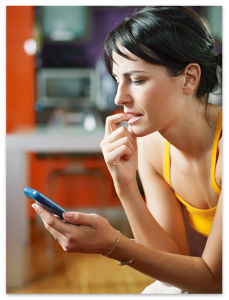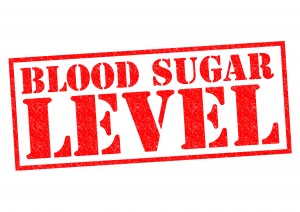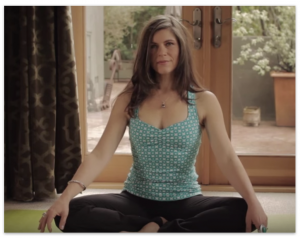Anxiety: 5 Ways to Reset from Anxious to Zen
 When most people think of anxiety, they envision someone having a full-blown panic attack, but the truth is that anxiety may show up in subtle and sneaky ways. In fact, from a more Eastern perspective, any time you move away from a feeling of peace, you are experiencing a form of anxiety.
When most people think of anxiety, they envision someone having a full-blown panic attack, but the truth is that anxiety may show up in subtle and sneaky ways. In fact, from a more Eastern perspective, any time you move away from a feeling of peace, you are experiencing a form of anxiety.
Consider the following questions. Do any of these occur for you more days than not each week?
- Are you able to sit still regularly and feel at peace, or do you feel uneasy?
- Do you feel on edge or like you constantly have something to do?
- Is it difficult to stop checking emails or social media for 24 hours, because you feel like you’re missing something important?
- Do you often feel like you are rushing?
- Do you ever lie awake at night thinking about your “to-do” list?
- Do you find it difficult to control your worries, or sometimes feel they are out-of-proportion to reality?
- Is your sense of worried accompanied by any of these other feelings: restlessness, easy fatigability, irritability, muscle tension, difficulty concentrating, and/or sleep disturbance?
If you responded “yes” to any of these questions, then you may have suffered from anxiety. Anxiety is a normal response to a stressor, but when prolonged and hard to control, it can become pathological. ((Jess Rowney, Teresa Hermida & Donald Malone, “Anxiety Disorders”, Cleveland Clinic, http://www.clevelandclinicmeded.com/medicalpubs/diseasemanagement/psychiatry-psychology/anxiety-disorder/Default.htm, accessed June 29, 2015.)) My craniosacral therapist has a different name for it: rev. I get overly rev’ed in my body and feel “stressed.” It’s like a throttle that is set a bit too high for my physiology, and my task is to decondition the habitual pattern. Or you may identify the feeling as overwhelm.
Regardless of the term that suits you best, if you feel anxious, you are not alone. Anxiety disorders affect about 40 million adults in the United States and even though it is highly treatable only about one affected person in three get treatment. ((Anxiety and Depression Association of America: Facts and Stats”, AADA, http://www.adaa.org/about-adaa/press-room/facts-statistics, accessed June 29, 2015; Kessler, R. C., et al. “Prevalence, Severity, and Comorbidity of Twelve-month DSM-IV Disorders in the National Comorbidity Survey Replication (NCS-R).” Archives of General Psychiatry 62, no. 6 (2005): 617-627.)) I urge you to talk to your primary care clinician about your feelings and to get help. Natural hacks work best when you’ve been screened first by a knowledgeable health professional.
What’s Wrong with the Worries?
Because anxiety is a form of stress, it causes the release of stress hormones like adrenaline and cortisol. They are designed to give you a quick boost of energy when you need to flee a dangerous situation.
The problem is your body doesn’t know the difference between an overwhelming day and being chased by a deadly beast. For this reason your cortisol levels can remain at “high alert” status even when you are just feeling a little anxious and are not actually in danger. This is an unfortunate artifact of our ancient nervous system.
Over time, chronically high cortisol levels can stress your adrenal glands, create hormonal imbalances, increase your blood pressure, “rev,” belly fat, sugar cravings, and insulin levels.
Before you start feeling anxious about this too, don’t worry! There are several things you can do to prevent these anxiety related symptoms from happening to you. Today I will show you 5 anxiety hacks you can use to get yourself into a healthier anxiety free state of mind naturally.
 Anxiety Hack #1 Avoid Blood Sugar Dips
Anxiety Hack #1 Avoid Blood Sugar Dips
When you go too long without eating, it can cause you to feel anxiety-like symptoms simply because your brain isn’t receiving enough glucose to function properly. ((Gorman, J. M., et al. “Hypoglycemia and panic attacks.” American Journal of Psychiatry 141 (1984): 101-102.)) I have found that for many people balancing blood sugar is enough to get rid of their anxiety completely.
Think about it this way: every time you think something like, “I am too busy with this spreadsheet to stop and eat.” or “I’m at my kid’s game right now, I’ll eat later,” you are choosing to allow anxiety symptoms to creep in. Just like your car needs fuel to run properly, so does your brain and it is important that you do not dismiss the importance of regular and nutrient-dense eating.
I also want to be clear that when I say your brain needs glucose to function it doesn’t mean you should eat unhealthy snack bars or a bag of chips. Fake carbs will spike your blood sugar, which activates the release of the hormone insulin. Insulin will then work overtime to reduce your blood sugar quickly often leaving your blood sugar lower than it was to begin with. This creates a blood sugar spike followed by a drop that will just keep the low blood sugar/anxiety cycle going.
What to do:
Eating small protein/fat snacks throughout the day is one way to keep your blood sugar stabilized. I keep almonds and macadamia nuts in my purse and car. Keep in mind that nothing works better than clean protein to stabilize your blood sugar.
 Anxiety Hack #2 Stop Drinking Coffee
Anxiety Hack #2 Stop Drinking Coffee
When you first drink a cup of coffee your adrenaline and epinephrine levels go up, this is why you feel like a rock star for the first 15 to 20 minutes. But after that something happens. You start to feel jittery, anxious, and just all-around bad.
This caffeine crash isn’t surprising since after about 15 to 20 minutes your adrenaline and epinephrine levels start to go down while your cortisol levels stay up. This is called the “cortisol switch” (a term I heard from Brendon Burchard), and it can cause anxiety symptoms to increase.
Consider this: using coffee to increase your energy levels is like using a credit card to buy something you cannot afford. It feels really good… until the bill arrives! In this case “the bill” is out of whack hormones, jitters, anxiety, and belly fat. We know the most adverse symptoms occur in people who are genetically programmed to be slow metabolizers of caffeine. But if you suffer from anxiety or overwhelm, the pros simply do not outweigh the cons.
As I describe in my new book, The Hormone Reset Diet, on page 133, coffee may make you anxious owing to contamination with mold toxins. Approximately 52 to 92 percent of coffee beans tested positive for mold, ((Martins, M. L., et al. “Incidence of microflora and of ochratoxin A in green coffee beans (Coffea arabica).” Food Additives and Contaminants 20, no. 12 (2003): 1127-1131; Studer-Rohr, I., et al. “The occurrence of ochratoxin A in coffee.” Food and Chemical Toxicology 33, no. 5 (1995): 341-355.)) and about 24 percent of the population is especially vulnerable to symptoms of mold toxicity, based on the HLA DR gene. ((Surviving Mold: Lab Tests, SurvivingMold.com, http://www.survivingmold.com/diagnosis/lab-tests, accessed June 29, 2015; Richie Shoemaker & Matthew Hudson, Suriving Mold : Life in the Era of Dangerous Buildings. Otter Bay Books, 2010.)) These problems motivated my friend Dave Asprey to create a new form of coffee that is vanishingly low in mold toxins. Still, you may be sensitive to coffee’s cortisol effects . . . .
What to do:
Have decaf coffee instead. It still contains a small amount of caffeine, which I find it is enough to feel noticeably more alert but without the anxiety. My favorite is Dave Asprey’s Decaf Bulletproof® Upgraded™ Coffee, which is low in mold.
Consider switching out your coffee for organic black and green teas, which contain much less caffeine than coffee, and green tea in particular has many health benefits, including modest risk reduction of cancer, diabetes, arthritis, cardiovascular disease, stroke, genital warts, and obesity. ((Hayat K., et al. “Tea and Its Consumption: Benefits and Risks.” Critical Reviews in Food Science and Nutrition 55, no. 7 (2015): 939-54; Henning, S. M., et al. “Epigenetic effects of green tea polyphenols in cancer.” Epigenomics 5, no. 6 (2013): 729-741; Yang, C., S. et al. “Recent scientific studies of a traditional Chinese medicine, tea, on prevention of chronic diseases.” Journal of Traditional and Complementary Medicine 4, no. 1 (2014): 17; Khan, N., et al. “Tea and health: studies in humans.” Current Pharmaceutical Design 19, no. 34 (2013): 6141.)).
Anxiety Hack #3 Learn to Say “No”
I think it’s safe to say that if you only had one thing to do every day you probably wouldn’t feel anxious or stressed out. Generally, it is your long to-do lists that cause you to think, “How the hell am I going to get through today?”
Many people are suffering from, what my good friend Dr. Pedram Shojai calls, “Time Compression Syndrome,” which he says occurs when you constantly try to fit too many things into a given amount of time. I am sure you can relate to cramming your schedule so tight that you don’t have enough time to get from point A to point B without running late and feeling anxious.
If you think you are a stellar multitasker, guess again. Research shows that multitasking is associated with poor attention skills, depression, anxiety, and a decrease in gray matter density in the brain. ((Loh, K., R. et al. “Higher media multi-tasking activity is associated with smaller gray-matter density in the anterior cingulate cortex.” (2014): e106698.))
This is why, as hard at it might be, it is so important for your anxiety levels that you learn how to say “no.” Or an alternative that a therapist friend recommends, described shortly.
Often, we say yes to things simply because we do not want to hurt someone’s feelings or we feel we should be able to do all things for everyone all the time. However, living this way only exhausts you mentally, physically, and emotionally.
What to do:
If you have a hard time saying “no” you might find it easier to say “probably not” instead. For example if you are asked to volunteer for something at your kid’s school but you know you can’t fit it in your schedule you can say, “Probably not, but let me get back to you.”
Anxiety Hack #4 Take a Deep Belly Breath and Anchor in the Present
Stress and anxiety cause shallow breathing (breathing that is high in the chest rather than low in the belly) because they trigger your sympathetic nervous system (fight or flight response) to activate.
Alternatively, lower belly breathing stimulates your vagus nerve, helping to counteract the sympathetic nervous system by triggering the parasympathetic nervous system. Deep breathing also causes the release of your body’s own form of valium, a neurotransmitter called GABA (short for gamma-aminobutyric acid).
Deep breathing is even more beneficial when it is coupled with meditation or mindfulness. Meditation lowers cortisol levels and raises serotonin, the “happy” brain chemical that is in charge of your moods, sleep, and appetite.
Meditation can also increase the density of the gray matter in your brain. One study found that as little as 8 weeks of meditation may significantly increase cortical density. ((Hölzel, B., K. et al. “Mindfulness practice leads to increases in regional brain gray matter density.” Psychiatry Research: Neuroimaging 191, no. 1 (2011): 36-43.)) This is particularly valuable for anyone who is a recovering multitasker (see anxiety hack #3).
What to do:
If you think you don’t have time to devote to deep breathing and meditation, start with 5 minutes. Download the free trial of the popular app Head Space onto your smart phone, or simply take a sacred pause of three belly breaths whenever you enter your passcode on a hand-held device. Even just a few minutes of quiet contemplation and deep breathing will help you hit the reset button.
 Anxiety Hack #5 Try Yoga
Anxiety Hack #5 Try Yoga
Most of us like quick fixes but with this article, more than anything, I want to show you that there are natural ways to control your anxiety before resorting to medication. For example, studies show that yoga is as or more effective than tranquilizers such as Xanax or Ativan. In Germany, a group of 24 women with anxiety were randomized to two 90-minute yoga classes per week for 3 months or a wait list. Significant reductions in both anxiety symptoms and salivary cortisol levels were found in the yoga group. ((Michalsen, A. et al. “Rapid stress reduction and anxiolysis among distressed women as a consequence of a three-month intensive yoga program.” American Journal of Case Reports 11, no. 12 (2005): CR555-CR561.)) In another randomized trial from UCLA, 28 women with mild depression were treated with yoga twice/week compared to a control group who did not do yoga. The yoga group had significant improvements in mood and anxiety after only 2.5 weeks in class. ((Woolery, A. et al. “A yoga intervention for young adults with elevated symptoms of depression.” Alternative Therapies in Health and Medicine 10, no. 2 (2004): 60-63.))
What to do:
Start going to a yoga class once per week at your gym. Begin your day with “Just One Pose,” a free series of single poses that I created on YouTube. Often, movement is helpful for anxious people, rather than sitting on a cushion and trying to meditate.
As a yoga instructor and functional medicine practitioner, I love the studies I’ve described; however, I am not suggesting that you dump your drugs without first consulting your clinician. It’s not either/or. I suggest that you incorporate these 5 hacks and see if your anxiety lessens, or even that your need for medication falls away. Maybe you’ll need less Xanax to feel in the present moment. You might find that managing your cortisol and anxiety levels naturally works even better for you than medication, without unpleasant side effects. I find that natural remedies help dampen the rev more effectively than prescriptions.